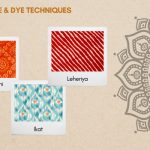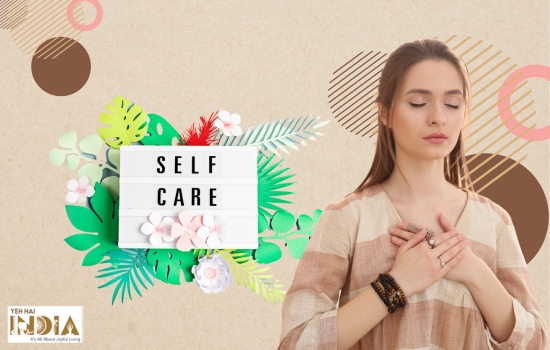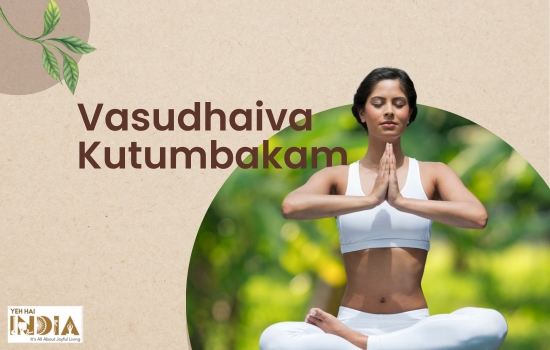Jute is a sturdy yet biodegradable fibre with many distinct applications that make it a perfect material for a variety of uses.
Also known as the golden fibre, jute is a type of textile fibre produced from the jute plant. Jute comes in a few distinct botanical types, but Corchorus olitorius is one of the principal species utilised to produce jute cloth (white jute) used to craft items of daily use.
Although it is more difficult to grow, the Corchorus capsularis (tossa jute) species of jute, it is thought to be superior than other varieties.
While cotton is the most abundant plant-based fibre, jute is a close second and comes with environment friendly features.
In India and its neighbouring countries, Jute is one of the main textile fibres used widely in manufacturing of goods, despite not being extremely well-liked in the West.
Growing upto 10 feets in height, Jute plants are suitable for sourcing, lengthy string of fibres for making ropes and other such purposes. In fact, Jute fibres are among the world’s longest natural textile fibres and are a great alternative to bamboo and cane.
Jute plant thrives in similar conditions as rice and grows best in warm climates with yearly monsoons.
Its cultivation, however, requires atleast 80% of humidity levels which must be met with adequate supply of clean water as the crop does not grow in hard water.
History of Jute:

In the Indian subcontinent, jute has been farmed for at least 5,000 years for textile use.
Although the Indus valley civilization or earlier societies may have also grown jute before this time, the oldest evidence of manufacturing of goods from fibres of this plant dates back to 3000 BC.
Despite the popularity and large scale production of cotton in India, Jute production was more significant during the evolution of Indian society over the millennia much before the European colonisation,
Jute became a lucrative crop with the arrival of British rule in India, which supported it’s applicability for a wide variety of uses..
Although jute had also been farmed for many years in Scotland, Bengal and other parts of India, it swiftly eclipsed Scotland in terms of production.
Many Scottish jute producers moved to this British colony to join the jute boom because of the enormous profits being earned by jute barons there.
After India gained independence, jute continued to be a key export from this area and was a vital part of the British Empire’s economy until the late 19th century.
Jute production, however, slowed in the later half of the 20th century with the introduction of synthetic fibres, and it wasn’t until the early 21st century that production of this plant fibre once again became a significant economic element in Bengal, Bangladesh, and other locations.
Recommended Story – Hemp Clothing: Health Benefits of Clothes Crafted From Hemp Fibre!
Benefits of Jute:

1. Needs Very Little Water
Jute can be grown and harvested repeatedly with very little water because it is a natural plant fiber. This is excellent for the environment in this era of water conservation.yg
2. Less Need for Fertilizers, Herbicides, and Pesticides
Since jute can grow with only a minimal amount of chemical support from fertilizer, herbicide, or pesticide, less chemical waste is dumped into the soil. In fact this crop is cultivated in many areas to improve soil quality to make it suitable for other crops.
3. Grows rapidly
Jute grows much faster, compared to other crops. It’s growth season lasts only about 190 days, which makes it a highly chosen plant.to ensure a steady flow of new fibre needed to manufacture eco-friendly goods.
4. Purifies air
According to studies, one hectare of jute plant crop absorbs up to 15 tonnes of carbon dioxide, a greenhouse gas, and releases up to 11 tonnes of oxygen in one growth season.
5. Enhances soil quality
When crops are rotated after the jute crop is harvested, the next cultivated crop will benefit because jute replenishes soil nutrients and lowers the danger of pests and diseases to plants.
6. Cost effective
Growing jute requires very little effort in the way of fertilisers, insecticides, and the like, and a little area may produce a lot of crop, making it a profitable choice that saves, money, land and time.
7. Biodegradable
Jute is a natural fibre that decomposes naturally after serving its purpose. If it ends up in a landfill, it will do so without causing any harm because it is biodegradable.
8. Reduces plastic pollution
Jute-made reusable shopping bags eliminate the need for disposable plastic bags. The majority of these single-use plastic bags wind up in landfills or as litter; only a small percentage of them are recycled.
By using a jute grocery bag, you can avoid using disposable bags and the associated pollutants.
Jute may be incredibly comfy when weaved into clothing. This is a pleasant perk regardless of whether jute fabric is made into apparel or a reusable bag.
5 Best Jute Products To Buy In India:
Amazon offers the top eco-friendly jute bags for various purposes:
- Sndia Jute Bags
- Ecotara Jute Bags
- Buyrite Jute Bags
- H&B Jute Bags
- LifeKrafts Jute Bags
1. Jute bags from SNDIA|
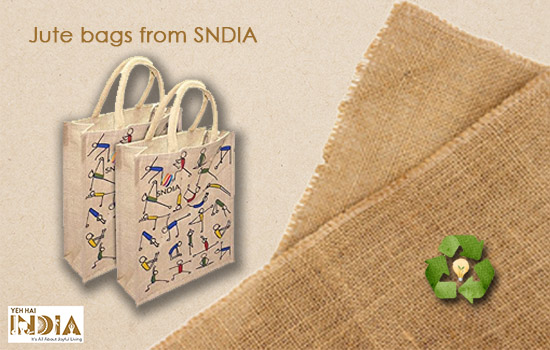
Sndia has an awesome range of jute bags that fulfill your needs perfectly. For increased strength, the interior of the SNDIA jute bag is laminated with natural jute or burlap.
It aids in preventing paper wastage and plastic pollution, allowing you to contribute to environmental protection.
Jute bags made by SNDIA include internal lamination for longer lifetime and superior stitching for durability. These strong shopping bags’ sturdy handles enable them to support heavier things while also enhancing their overall toughness.
The lunch bags stand out because of their stylish colours and craftsmanship. You shouldn’t use water to wash these bags. If required, clean the area with a soft cloth.
Because the interior of the bag is laminated, we may wipe it down with a moist cloth. Avoid keeping this jute bag close to a flame or other hot surfaces.
The bags may be folded and collapsed, which makes organisation and storage quick and easy. These bags are made by hand using eco-friendly inks. Due to the padded handles, the bags can be held in the palm and slung over the shoulder.
Along with groceries, these bags can be used to transport other goods like lunchboxes, water bottles, and more.
Dimensions : 30 x 12.5 x 34 cm
Recommended Story – All You Need To Know About Zardozi Embroidery
2. ECOTARA Jute Lunch Bag with Bottle Holder|
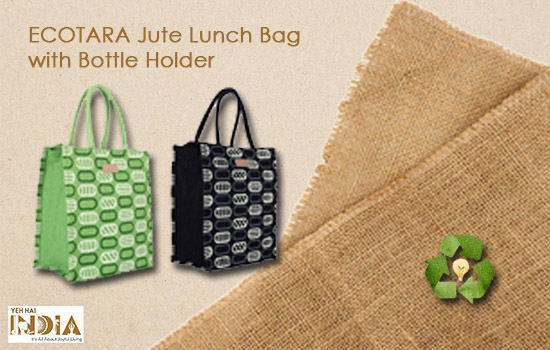
The Ecotara store sells premium, environment friendly ECOTARA jute lunch bags that are produced from natural jute and have a robust inside lamination to prevent theft.
Strong, premium-quality zipper with an interior cutlery pocket. A 3″or 4″ container lunch box and a 900 ml water bottle fit snugly in the cutlery pocket.
Rope handles that are strong and sturdy are supplied for simple carrying. Dust resistance comes inherent to jute. So, refrain from washing in water. If required, clean the area with a soft cloth. Because the interior of the bag is laminated, we may wipe it down with a moist cloth.
Using jute of the highest calibre, trained artisans produce the ECOTARA product line. The patterns are original and fashionable.
It has enough room for all the necessary possessions. Due to its timeless black and white pattern, this jute bag can be used by men and women.
Dimensions : 30 cm X 26 cm X 1.5 cm
3. BUYRITE’s Jute Bags|
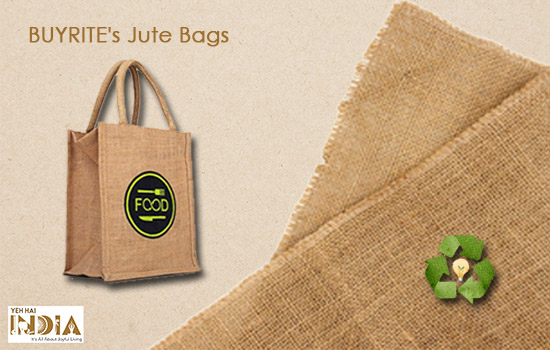
High-quality materials are used to make BUYRITE’s jute lunch bags, making them durable. It has a carrying capacity of around 10 kg. They have fashionable designs and are environment friendly.
Whether it be men, women, or even children, the elegant jute natural colour with the Food logo in black and green looks wonderful and appeals to both genders.
These eco-friendly burlap cloth lunch box bags are one of the best plastic substitutes for securing food and storing fruits for longer.
They are versatile bags. As a result, they may be used as a tote bag, office bag, handbag, shopping bag, picnic bag, etc. The bag is about 210 grams in weight.
Dimensions : 31 x 22.86 x 2.69 cm
4. H&B Printed Jute Tiffin Bag with Zipper|
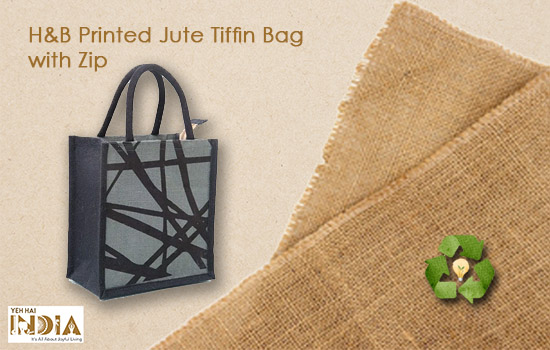
Burlap or natural jute are laminated on the inside for added strength when creating H&B Jute Bags. H&B Printed Jute Tiffin Bag with Zip are reusable, portable, cosy, and long lasting.
These environment friendly bags are also foldable and collapsible, which simplifies organisation and storage.
To create a waterproof bag, these are laminated with water-resistant material. The lamination increases the fabric’s useful life and protects it from moisture and precipitation. Additionally, it has a convenient hanging loop for easy accessibility.
Three compartments are included in this bag: a large one for lunch boxes, a compartment for spoons, forks, and tissue paper, and a third for a 1-liter water bottle.
The reusable bags are manufactured by hand with simple tools and printed with eco-friendly inks.
Dimensions : 25.4 x 15.24 x 27.94
5. LifeKrafts Jute Pouches|
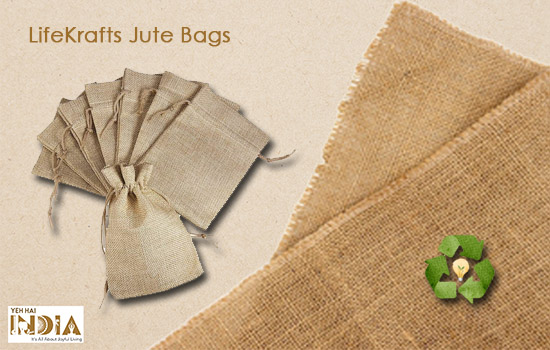
This range of jute handbags from LifeKraft is a great choice for women in search of a tote bag. They can be worn on the wrist or tucked into the waist.
Coins, coffee beans, and other items can also be kept in them. These little pouches also make wonderful gift packages. Each bag features a drawstring closure, which makes it easy-to-open and close and makes it great for storing.
The bags are available in sets of 10, 20, 30, 50, 70, and 100 with seven different sizes in a similar range. Due to their luxurious interiors, robust designs, and exquisite craftsmanship, this range of bags is ideal for every circumstance.
Summary:
Jute is an affordable, and environment friendly material, thanks to all of these advantages, which make it one of the best natural fibres for making of shopping bags.
Its time to give jute some thought if you’re planning to design a unique, reusable bag for your company.
Also Read – Hemp Fabric: Sustainable, Renewable and Eco-friendly For Your Lifestyle





